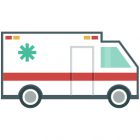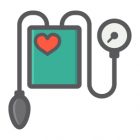Maintaining Your Health During a Pandemic – Avoiding necessary care can have dire consequences
Despite the current focus on COVID-19, people are still experiencing other serious health issues like heart problems, strokes, complications from chronic conditions like diabetes, and more. Maintaining your health is a top priority right now. Refer to this guidance for helpful strategies to continue taking care of yourself and your loved ones during this pandemic and beyond.
Safety is a top concern, but knowing when and how to seek care can help you maintain your health and well-being through this challenging period. We can help guide you.

Addressing urgent health issues and emergencies

Managing chronic conditions

Continuing preventive care
A Special Video Message
Raffi Terzian, MD, MPH
Senior Vice President, Clinical Operations
Senior Medical Director, Health Advocate
Dr. Terzian shares more about this guide and the importance of continuing to take care of yourself throughout this unprecedented time. He is a board-certified Emergency Physician with over 25 years of clinical and administrative experience and has served on the faculty of leading academic medical centers and top teaching hospitals. He also holds a Master’s degree in public health and has experience in occupational health.
Your Resource Guide

Addressing urgent health issues and emergencies
Time is of the essence to receive appropriate, and sometimes lifesaving, treatment. It is important to not ignore signs or symptoms of a potentially serious issue or delay contacting your healthcare provider. Keep this in mind should any urgent issue arise during this time.
If you or a loved one is experiencing an urgent health issue, such as illness or injury, taking these steps can help avoid delays and safely seek care:
- Call 911 if symptoms include unconsciousness, chest pain, trouble breathing, uncontrollable bleeding, severe pain or other emergency issues. The dispatcher will walk you through what to do next as the ambulance heads your way.
- Contact your healthcare provider. Your provider may be available for a phone consultation or through a telehealth virtual visit. They can review your symptoms and determine the best course of action. If necessary, they can help guide you to the appropriate facility for care. Additionally, if you have access to a telemedicine service through your employer, this can be a great resource to help review and discuss your symptoms and seek care.
- In situations where an urgent care or ER is needed, it may be helpful to call ahead so preparations can be made in advance.
- When visiting a healthcare facility, there are a few things to keep in mind. You may be concerned about contracting COVID-19, but it is also important to recognize that hospitals and other medical facilities are taking every precaution to protect both staff and patients, including those with and without COVID-19. Depending on the circumstances, when you arrive, you may be screened for fever or other symptoms prior to entering and then directed to an appropriate area for conditions that may not be COVID related. Do not be alarmed that the providers will be wearing personal protective equipment – this is for your safety and theirs, even if you do not have symptoms of COVID-19.
Knowing what to expect and how to protect yourself in an urgent or emergency health situation can help ensure you safely and quickly receive the care you need.

Managing chronic conditions
For people with chronic conditions like diabetes, high blood pressure, or asthma, continuing to appropriately manage care is critical at all times, especially now. Maintaining health and well-being through adherence to your prescribed treatment plan can help avoid ER visits and long-term issues. There are a number of resources available to help stay ahead of chronic diseases, despite current challenges.
Pharmacy Options – Maintenance medications are a key component of treatment for many chronic conditions. In order to avoid running out and safely refill your prescription, consider utilizing the drive-through at your regular pharmacy or moving your prescription to a mail order pharmacy. Mail order pharmacies can provide a longer supply of medications, making sure you have enough to last for an extended period. Make sure to let your provider know if you need medication.
Telemedicine – While it may not be possible to have an in-person office visit, it is important to keep your regular appointments. You may be able to access your provider through virtual visits or phone consultation so that you can review and discuss your ongoing care. It may also be possible to access care through telemedicine services provided by employers.
Support Services – Additionally, your employer may provide other programs like advocacy and coaching specific to the care of chronic conditions. Nurses and other experts can help connect you with providers, identify pharmacy options in your health plan, and share information and guidance to help manage your condition. Contact your HR department to find out what might be available to you.
Ongoing management of chronic conditions can help you and your providers work together to address health issues sooner rather than later, potentially preventing challenges beyond the COVID-19 pandemic.

Continuing preventive care
The most effective way to maintain your health and well-being is by staying on top of recommended preventive care. Visiting your doctor may not look the same as it usually does, and it may take extra time to coordinate, but there are still ways to be proactive about your care. For example, before cancelling an existing appointment for an annual or other preventive visit, contact your provider.
Depending on the nature of the visit, some doctors have transitioned to virtual or telehealth options. While this may not be possible for all visits (like dental or vision exams), it can be a great way to continue the dialogue with your physician about your overall health. If anything you discuss needs further attention, you can address it in a timely and appropriate way.
Some offices may still be seeing patients for in-person well visits, especially pediatricians. Kids should still be receiving scheduled immunizations, so check with your children’s provider to confirm how they are continuing care at this time.
If you do need to visit the office for a screening or immunization, take precautions – wear a mask, clean your hands regularly and follow any other procedures outlined by your provider.
More from the Blog
While it can be challenging right now, do what you can to continue eating well and exercising. It will involve some creativity, but incorporating healthy foods into your diet or doing a workout video at home can benefit both your physical and mental well-being.

Fitting in fitness at home
A busy schedule can derail even the most committed exerciser! These tips may help you fit in more fitness at home.

Stay focused by taking a mindfulness break
No matter where you are—on the job or off—you can use a simple mindfulness technique as a convenient way to focus on the present moment and task at hand, slowing down body and mind to help you better cope with stress.

Create a healthy space to work at home
Even if you have a less than ideal working space available, these tips can help optimize your comfort and efficiency.
Let us know how we can help.


